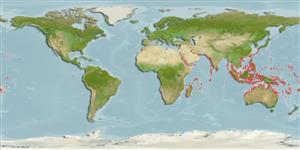>
Blenniiformes (Blennies) >
Blenniidae (Combtooth blennies) > Blenniinae
Etymology: Petroscirtes: Latin, petra, -ae = stone + Greek, skirteo = to jump.
More on author: Rüppell.
Environment: milieu / climate zone / depth range / distribution range
Ecologia
marino associati a barriera corallina; distribuzione batimetrica 0 - 8 m (Ref. 86942). Tropical; 30°N - 30°S
Indo-Pacific: Red Sea and East Africa to the Phoenix, Samoan and Tongan islands, north to Ryukyu Islands, south to Australia and New Caledonia.
Size / Peso / Age
Maturity: Lm ? range ? - ? cm
Max length : 8.5 cm TL maschio/sesso non determinato; (Ref. 48636)
Short description
Chiavi di identificazione | Morfologia | Morfometria
Spine dorsali (totale) : 10 - 11; Raggi dorsali molli (totale) : 14 - 17; Spine anali: 2; Raggi anali molli: 14. Head and body speckled and mottled; 5-6 indistinct, dark blotches or bands on body usually with dark-edged ocelli above (Ref. 4404). First three rays of dorsal fin are elevated.
Adults are found solitary or in small groups (Ref. 90102) in shallow protected lagoons and reef flats with algal and seagrass clumps. Juveniles often in floating Sargassum weeds and maybe dispersed over great distances (Ref. 48636). They swim with the tail oriented vertically. Oviparous. Eggs are demersal and adhesive (Ref. 205), and are attached to the substrate via a filamentous, adhesive pad or pedestal (Ref. 94114). Empty mollusk shells are used for nesting. Larvae are planktonic, often found in shallow, coastal waters (Ref. 94114). Captured at the surface using a hand net (Ref. 26165).
Life cycle and mating behavior
Maturità | Riproduzione | Deposizione | Uova | Fecundity | Larve
Oviparous, distinct pairing (Ref. 205).
Myers, R.F., 1991. Micronesian reef fishes. Second Ed. Coral Graphics, Barrigada, Guam. 298 p. (Ref. 1602)
IUCN Red List Status (Ref. 130435: Version 2024-1)
Threat to humans
Harmless
Human uses
Pesca: commerciale; Acquario: Commerciale
Strumenti
Special reports
Download XML
Fonti Internet
Estimates based on models
Preferred temperature (Ref.
123201): 25 - 29.3, mean 28.4 °C (based on 3369 cells).
Phylogenetic diversity index (Ref.
82804): PD
50 = 0.5005 [Uniqueness, from 0.5 = low to 2.0 = high].
Bayesian length-weight: a=0.00575 (0.00253 - 0.01308), b=3.06 (2.86 - 3.26), in cm total length, based on LWR estimates for this (Sub)family-body shape (Ref.
93245).
Trophic level (Ref.
69278): 2.0 ±0.0 se; based on diet studies.
Resilienza (Ref.
120179): Alto, tempo minimo di raddoppiamento della popolazione meno di 15 mesi (Preliminary K or Fecundity.).
Fishing Vulnerability (Ref.
59153): Low vulnerability (10 of 100).
Nutrients (Ref.
124155): Calcium = 186 [90, 329] mg/100g; Iron = 0.926 [0.515, 1.667] mg/100g; Protein = 17.9 [16.6, 19.0] %; Omega3 = 0.0796 [, ] g/100g; Selenium = 21.2 [9.9, 49.2] μg/100g; VitaminA = 114 [28, 469] μg/100g; Zinc = 2.83 [1.81, 4.20] mg/100g (wet weight);
